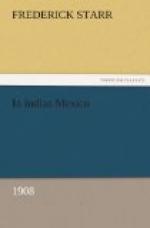Down in the valley, across a little stream, we struck into a pleasant meadow road leading to the Hacienda of San Bartolo. Suddenly, before us, in the road, we saw a man lying. We thought he was dead. He was a young man, an indian in the usual dress, apparently a Zapotec. His face was bloody and his shirt was soaked in front with blood, which had trickled down upon the ground forming a pool in which he lay. We could see no deep wound, but, as he lay upon his side, there may have been such. Near him in the road there lay a knife, the blade covered with blood. The man lay perfectly still, but we fancied we could see a slight movement of the chest. In Mexico, it is best not to investigate too closely, because the last to touch a murdered man may be held responsible for his death. So we hurried on toward the hacienda but, before reaching it, met two girls about nineteen years of age and a little lad all Zapotecs. We told them what we had seen and bade them notify the authorities. One of the girls cried, “Si, Senor, es mi hermano” ("Yes, sir, it is my brother"), and they ran down the road. As for us, we hurried onward, without stopping at the hacienda, in order not to be delayed or held as witnesses.
There is no love between the Zapotecs and Mixes. We never learned the actual story, but imagined it somewhat as follows. The old Mixe, carrying his burden, had probably encountered the young Zapotec and had words with him. Probably there had been blows, and the old man was having the worst of it when his companions came along and turned the tide of battle.
The road, after passing the hacienda, ascended almost constantly for many miles. We passed clumps of yuccas. As we mounted we faced a strong and cutting wind, and were glad when any turn in the road gave us a moment’s relief. The final ascent was sharp and difficult, up a hill of red or purple slate, which splintered into bits that were both slippery and sharp to the feet of our poor animals. Just as the sun was setting and dusk fell, we reached the miserable pueblo of Santa Maria Albarradas. It was situated on a terrace or shelf, and its little houses were made of red or purple adobe bricks, and thatched with grass. Little garden patches and groups of cultivated trees surrounded the houses. The church was little larger than the dwellings, and was constructed of the same clay, thatched with the same grass. Near it was the town-house. We summoned the presidente, and while we waited for him, the men, women, and children of the town thronged around us and watched our every movement, commenting the while on our actions and words. When the presidente came, we made known our wants and soon had supper for ourselves, food for our animals, a shelter for the night, and a mozo as guide for the morrow. The town-house was put at our disposition; it was sadly in need of repairs, and consisted of two rooms, one larger than the other.




